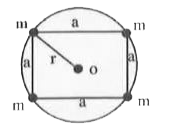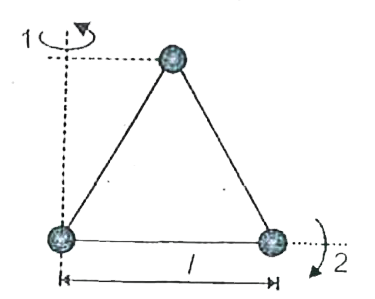Four particles each of mass 'm' are located at the four corners of a sqaure of side a. If the system is revolving in a circle due to thei mutual force of attraction then the angular velocity and time period of each particle is

The gravitational force between the masses provides the necessary centripetal force
Gm1m2d2=m1r1ω2→(1)
The distance of centre of mass from m1 is
r1=m2dm1+m2→(2)
From (1) and (2) Gm1m2d2=m1m2dm1+m2.ω2
(or) ω2=G(m1+m2)d3 (or) ω=√G(m1+m2)d3
The resultant gravitational force on one of the particles
FR=√2Gm2a2+Gm22a2
This gravitational force provides the necessary centripetal force
mrω2=Gma2(√2+12)⇒
a√2ω2=Gma2(2√2+12)⇒ω=
⎷Gma3(2+1√2)andT=2πω=2π
⎷a3Gm(√22√2+1)
Similar Questions
Knowledge Check
Four particles each of mass m are placed at the vertices of a square of side l. the potential at the centre of square is
A−√2Gm2l(2−1√2)B−2Gm2l(2+1√2)C−√2Gm2l(√2−1√2)D−2Gm2l(√2−1√2)
Four particles of equal mass are moving round a circle of radius r due to their mutual gravitational attraction . Find the angular velocity of each particle .
View SolutionThree particle each of mass m are placed at the corners of equilateral triangle of side l

Which of the following is/are correct ?
View SolutionFour identical particles each of mass m are arranged at the corners of a square of sie a. If mass of one of th particle is doubled, the shift in the centre of mass of the system is
View SolutionFour equal masses (each of mass M) are placed at the corners of a square of side a. The escape velocity of a body from the centre O of the square is
View SolutionFour bodies each of mass m are placed at the different corners of a square of side a. find the work done on the system to take any one body to infinity.
View SolutionTwo particles of equal mass m0 are moving round a circle of radius r due to their mutual gravitational interaction. Find the time period of each particle.
View SolutionFour particles each of mass 'm' are kept at the four corners of a square of edge 'a'. Find the moment of inertia of the system about a line perpendicular to the plane of the square and passing through the center of the square.
View Solution
